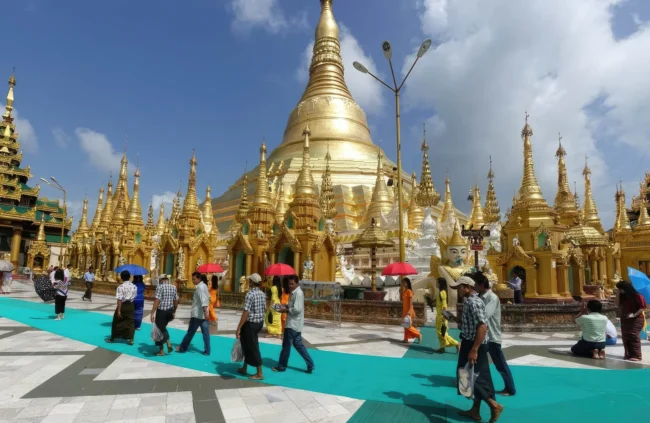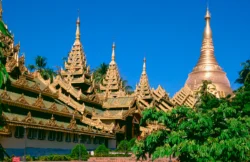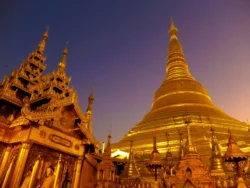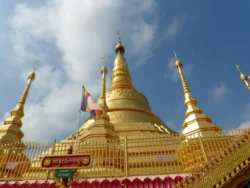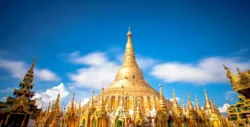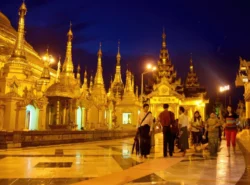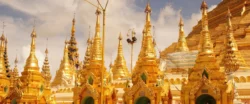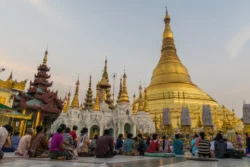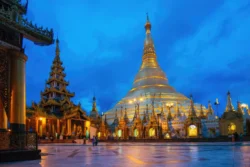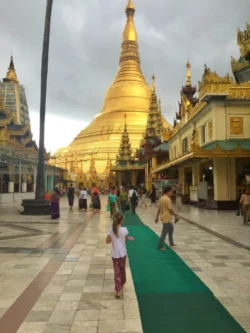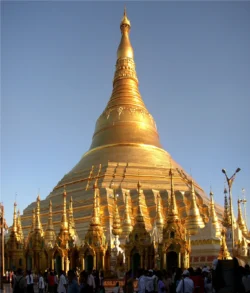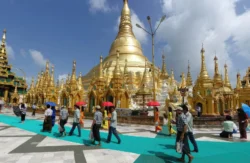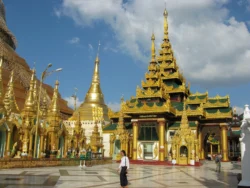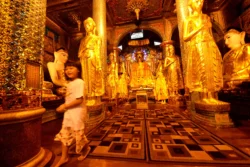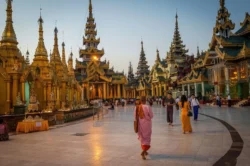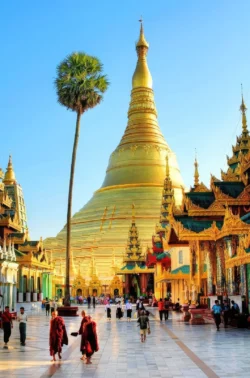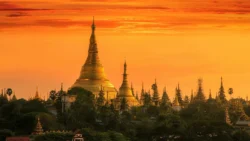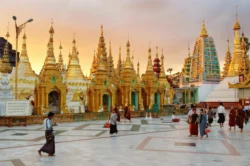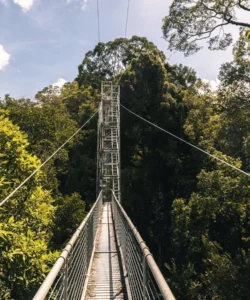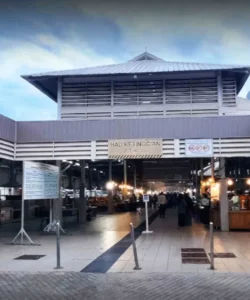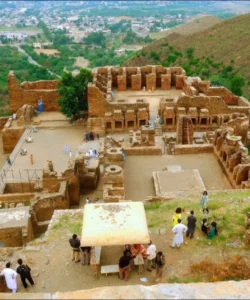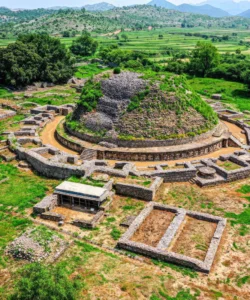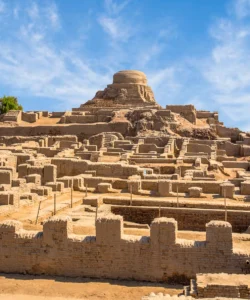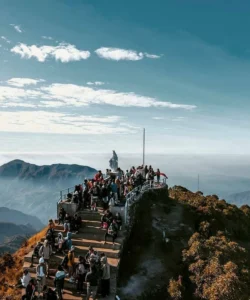The Shwedagon Pagoda, officially named Shwedagon Zedi Daw, is undoubtedly the most sacred and iconic Buddhist site in Myanmar. This resplendent gilded stupa dominates the skyline of Yangon and stands as a dazzling symbol of Myanmar’s rich spiritual heritage and artistic prowess.
Name: Shwedagon Pagoda (Burmese: ရွှေတိဂုံစေတီတော်, officially Shwedagon Zedi Daw; also known as the Great Dagon Pagoda or the Golden Pagoda)
Address: U Wisara Road, Dagon Township, Yangon, Myanmar. It is situated majestically on Singuttara Hill (also spelled Singuttara Hill), west of the Royal Lake (Kandawgyi Lake), and is visible from much of Yangon city.
How to Get There:
The Shwedagon Pagoda is a central landmark in Yangon and easily accessible:
- By Air: The closest airport is Yangon International Airport (RGN). From the airport, it’s about a 30-45 minute taxi or Grab ride to the pagoda.
- By Taxi/Ride-Sharing (Grab): Taxis and Grab are readily available throughout Yangon and can drop you off directly at one of the four main entrances to the pagoda.
- By Bus: Numerous local bus routes serve the Shwedagon Pagoda. Look for stops around the pagoda complex.
- By Foot: If you are staying in a hotel near Kandawgyi Lake or the Dagon Township, the pagoda might be within walking distance.
- Four Main Entrances: The pagoda has four covered monumental stairways leading up Singuttara Hill from the four cardinal directions (North, South, East, West).
- The Southern Stairway is often considered the main entry, traditionally used by pilgrims arriving from the riverfront, and has elevators for accessibility.
- The Western Entrance has escalators.
- The Eastern Stairway often offers the most “authentic” ambiance, passing through monasteries and stalls.
- Entrance Fee: There is an entrance fee for foreign visitors (usually 10,000 Kyats or 8 USD).
- Dress Code: As a sacred site, visitors are required to dress modestly (shoulders and knees covered). Footwear must be removed before ascending the stairways or entering the main platform. There are designated shoe storage areas.
- Best Time to Visit: Early morning (before 9 AM) or late afternoon/evening (after 4 PM) are ideal. The weather is cooler, and the pagoda is less crowded. At sunset, the golden stupa glows spectacularly, and the atmosphere becomes particularly vibrant with devotees.
Landscape and Architecture:
The Shwedagon Pagoda is an unparalleled example of Burmese religious architecture, characterized by its dazzling golden stupa, intricate ornamentation, and a layout that mirrors Buddhist cosmology.
- Gilded Stupa on a Hill: The central and most dominant feature is the magnificent gilded stupa, standing approximately 110 meters (360 feet) high, on the 114-acre Singuttara Hill. Its entire surface, from the brick base to the crown, is covered with hundreds of thousands of genuine gold plates, donated over centuries by monarchs and commoners alike.
- The Hti (Umbrella Crown) and Finial: The very top of the stupa is adorned with a hti, a traditional Burmese umbrella-shaped crown. This hti is literally encrusted with thousands of diamonds (over 5,450), rubies (over 2,300), sapphires, and other precious gems. At the very pinnacle is a single, spectacular 76-carat diamond bud. Sunlight reflecting off this diamond can produce dazzling multi-colored rays.
- Terraced Platforms: The stupa rises from a series of terraced platforms (pissaya) on Singuttara Hill, accessible via the four covered stairways. These platforms are lined with hundreds of smaller stupas, shrines, pavilions, assembly halls (tazaungs), monasteries (kyaungs), and bells.
- Cosmological Layout: The spatial arrangement of the shrines and features on the main platform follows a system derived from Hindu-Buddhist cosmology, with planetary posts representing zodiac positions around the central stupa. Devotees visit the shrine corresponding to their day of birth.
- Relic Chamber: The pagoda is believed to enshrine sacred relics of the four previous Buddhas of the present kalpa: the staff of Kakusandha, the water filter of Koṇāgamana, a piece of the robe of Kassapa, and most importantly, eight strands of hair from the head of Gautama Buddha. These relics are believed to be encased deep within the solid core of the stupa.
- Architectural Synthesis: While rooted in South Asian prototypes for stupa design, Shwedagon has evolved over centuries with unique Burmese embellishments, intricate wood carvings, and the incorporation of various structural elements reflecting different eras and donations.
- Devotional Halls (Ayongantazaung): Four large devotional halls are oriented to the cardinal directions, providing access to the central stupa platform. These halls are often richly decorated with carvings and murals depicting Jataka tales (stories of Buddha’s previous lives).
- Giant Bells: The pagoda complex houses several large bronze bells, including the Maha Ganda (Great Bell of Dhammazedi), which is famous for being lost in the river. Another is the Singu Min Bell (Maha Tissada Ghanta), weighing over 40 tons.
What Makes It Famous:
- Most Sacred Buddhist Pagoda in Myanmar: It is the holiest Buddhist site in Myanmar, believed to contain relics of four Buddhas, making it a pivotal pilgrimage destination for Buddhists worldwide.
- Dazzling Gold and Jewels: Its overwhelming grandeur, covered with hundreds of tons of gold leaf and encrusted with thousands of diamonds and precious gems, is simply breathtaking and world-famous. It literally shines.
- Ancient Origins: Legend states it is over 2,600 years old, which would make it the oldest Buddhist stupa in the world (though historical evidence suggests 6th-10th century CE). This ancient legacy adds to its profound spiritual and historical significance.
- Symbol of Myanmar: The Shwedagon Pagoda is the undisputed national symbol of Myanmar, representing its enduring faith, rich heritage, and enduring spirit. It has also been a focal point for political resistance and civic gatherings.
- Architectural Masterpiece: It is considered a unique masterpiece of Buddhist architecture, showcasing a harmonious blend of traditional Burmese styles and drawing upon centuries of artistry and devotion.
- Vibrant Spiritual Atmosphere: The pagoda is a living, active place of worship. Witnessing the constant stream of devotees performing rituals, making offerings, meditating, and praying creates an incredibly vibrant, serene, and immersive spiritual experience.
- Iconic Yangon Skyline: Its majestic golden silhouette dominates the Yangon skyline, making it the city’s most recognizable landmark, especially when illuminated at night.
Differences from Some Other Wonders:
- Gilding and Jewel Adornment: While other temples might have golden domes or statues (e.g., Sultan Omar Ali Saifuddien Mosque, Jame’ Asr Hassanil Bolkiah Mosque, some temples in Bagan), the Shwedagon’s entire massive stupa is covered in solid gold plates, topped with a hti literally encrusted with thousands of diamonds and gems. This sheer scale of precious metal and jewels makes its ornamentation unique.
- Enshrined Relics of Four Buddhas: Its claim to house relics from all four of the present kalpa’s Buddhas (especially eight strands of hair from Gautama Buddha himself) makes it exceptionally sacred and sets it apart from other stupas that might enshrine relics from one Buddha or specific saints.
- Living, Active Pilgrimage Hub on a Grand Scale: While many temples are active, the Shwedagon is a perpetual, bustling, and deeply active pilgrimage center on a scale that transforms it into a microcosm of Burmese Buddhist life, with constant rituals, offerings, and prayers by thousands of daily visitors. This scale of living devotion is profound.
- Symbol of National Identity on an Unparalleled Level: While Angkor Wat is on Cambodia’s flag, the Shwedagon’s omnipresence in Myanmar’s daily life, its long history of continuous repair and embellishment by generations of monarchs and commoners, and its role as a focal point for national identity and even political movements, give it a unique and unparalleled symbolic weight within its nation.
- Architectural Evolution through Continuous Merit-Making: Unlike ancient ruins that are static or restored to a specific period, the Shwedagon’s present form is a result of centuries of continuous additions, embellishments, and repairs (often after earthquakes) driven by the Buddhist concept of merit-making, making it a living architectural history that embodies the accumulated devotion of generations.
- No Interior Access: Like the Qutub Minar, the main stupa is solid and not open to the public for interior exploration. Visitors experience its grandeur from the surrounding platforms and prayer halls, which contain myriad smaller shrines.
Shwedagon Pagoda Photos:
